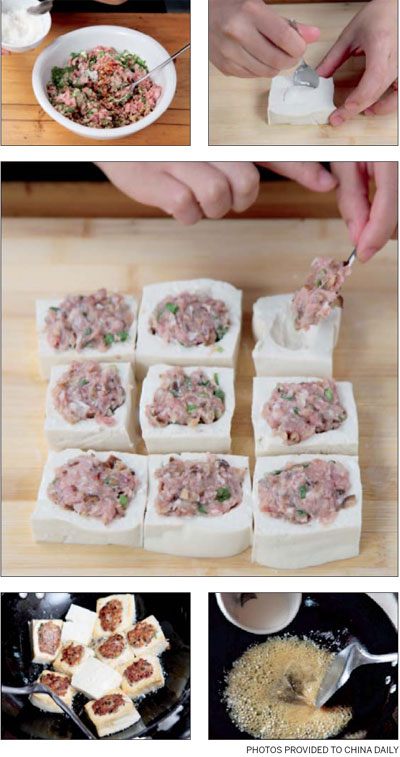Get a Hakka-ing for tofu
Updated: 2012-03-02 07:58
By Catherine Chan (陈精美) (China Daily)
|
|||||||||||

China's 'guest people' Show ingenuity with niang doufu, a hearty spin on dumplings
客家文化在祖先不断迁居的生活中沉淀下来,客家菜也跟随着他们传遍世界。其中,就有我们现在介绍的酿豆腐。
Niang doufu (酿豆腐), better known outside China as yong doufu (酿豆腐), is a classic dish belonging to the Hakka people. Much like its originators, Hakka cuisine is hearty and robust, and well known throughout the world due in large part to Hakkans' leading part in the Chinese global diaspora.
 |
Though the Hakka (客家 kejia, or "Guest") people originated in central China, they are known for having dispersed throughout the south. To fit their migratory habits, the thrifty and hardworking Hakka developed a cuisine known for its pragmatism and relative simplicity - pickling, salting and braising are all favored for their ability to preserve food, making it portable.
It's just this kind of ingenuity that led to the invention of niang doufu. The story goes that enterprising Hakka migrants, who were short on wheat, improvised jiaozi (饺子, steamed meat dumplings) by using tofu instead of the usual pastry skin.
Today niang doufu is a rustic home-style dish with hundreds of variations that is loved by Chinese and non-Chinese alike, having spread to such far-flung places as Jamaica and Bangladesh - both, incidentally, beneficiaries of one of the later waves of Hakka migration.
The many variations, in both name and recipe, have also led to some confusion. In the Hakka dialect yong (酿) means "to stuff " or "insert", while in standard Mandarin, niang (酿) usually means "brewed" or "fermented". But rest assured there is no long, drawn-out fermenting process. Traditional niang doufu is, simply, soft white tofu coated in cornstarch, stuffed with a pork filling and braised. This kind of soft, silky tofu, and its endless uses, holds a strong appeal in Hakka cuisine.
Not only is it an excellent, low-fat source of protein, but its subtle natural taste allows it to marry easily with a variety of stronger flavors.
Versions include fish stuffing and a mixture of fish and pork (or alternative seafood), all spiced to taste.
Chef Suer Zhou notes, "We sometimes use cured fish or hami (salted dried prawn) to create more depth of flavor in the dish".
More often than not, cornflour is added to the stuffing mixture, which is chopped and whipped to a bouncy, almost mousse-like consistency to ensure a light bite.
Overseas, where the dish has evolved to become yong doufu, cooks' imaginations have become the limit as different regional ingredients have led to the evolution of countless varieties. Favorite stuffings include the addictively adult-tasting bitter gourd, silky smooth eggplant, fiery large chili peppers, mushroom caps, okra or ladies' fingers and crisp bean curd skin.
The options for cooking are equally numerous. Braising is the most traditional method, and will result in a light, unctuous sauce that suits a lighter palate. Deep frying is another method, which renders the tofu pleasantly crispy.
As far as dipping sauce goes, some prefer sweet, but the most important thing is that you have a good hot chili sauce.
When deep frying, it is best to use doufu pok (a kind of golden, pre-fried tofu that's crispy on the outside and fluffy on the inside) as retains its shape better during the frying process and has less water content to react with hot oil.
Another alternative is to boil your ingredients in a light fish stock or pork or chicken consomme, and pair it with rice or egg noodles for a complete meal. A good accompanying sauce is also necessary for this more qing (light) dish.
Upping the ante for those with more heat-loving tastebuds is yong doufu laksa, a take on the iconic Malaysian and Singaporean spicy soup noodle dish laksa. This version of niang doufu uses a spicy laksa soup comprising onions, lemongrass, turmeric, coconut milk, herbs and spices to create a fragrant broth, which infuses the stuffed ingredients with the flavors of Southeast Asia.
Courtesy of The World of Chinese, www.theworldofchinese.com
Today's Top News
Rescuers race against time for quake victims
Telecom workers restore links
Coal mine blast kills 18 in Jilin
Intl scholarship puts China on the map
More bird flu patients discharged
Gold loses sheen, but still a safe bet
US 'turns blind eye to human rights'
Telecom workers restore links
Hot Topics
Lunar probe , China growth forecasts, Emission rules get tougher, China seen through 'colored lens', International board,
Editor's Picks

|

|

|

|

|

|





